Your kitchen pots and pans get a lot of hard wear, and that can leave them stained or damaged. To get the most out of your cookware, learning how to clean pans is a must. Luckily, our cleaning Pros know a thing or two about cleaning all kinds of pots and pans so that they gleam like new. Learn our top tips now and keep your kitchen clean and healthy!
How To Clean Pots and Pans Like a Pro
How to clean baking pans in 5 minutes
The best time to clean your pots and pans is when they’re still hot from cooking. Simply pour hot water into the pan to deglaze it. This can lift even burned-on food and grease in an instant. Take care, however, to only use hot water with a hot pan. Otherwise, you risk thermal shock, which can cause a pan to warp.
Once the pan has been deglazed, use a sponge or scourer and a drop of dish soap to clean the pan. Then rinse thoroughly with plain water. That’s it! Your pan is fresh and clean again.
Pro Tip: Keep your pans clean by cleaning your glass-top stove!
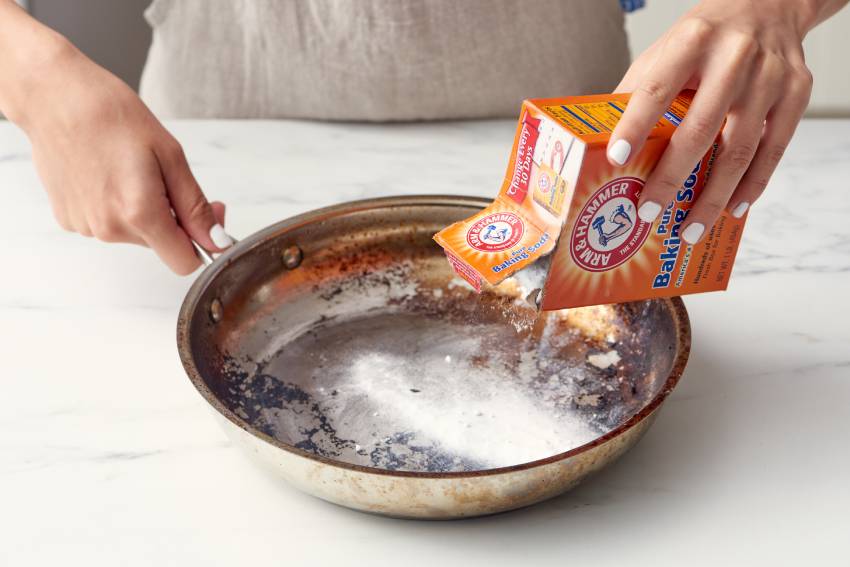
How to clean pans with baking soda
If your pan cooled down with food residue inside it, it can be tougher to clean. First, scrape out any grease or food remains and discard them in the trash. Don’t put grease or oil down your sink, as it can clog your pipes. You can use an old jar or soda can to store used grease and then throw it away.
Use a brush or scouring pad to remove any remaining marks. Hot water and a drop of dish soap will cut through grease and clean the pan in no time. But if you’ve got burned-on food or grease scorch marks on the pan, it’s time to break out the baking soda.
- Clean the pan as much as possible
- Make a paste with baking soda and a little water
- Spread the paste across the bottom of the pan
- Let it sit for 5 minutes
- Take a scouring pad and work in circles across the pan to loosen the stains
Another way to clean a pan with baking soda is to make a mixture of 1 cup of water and 2 tablespoons of baking soda. Pour into the pan until the bottom is covered to about ½ inch deep. If the stain goes up the sides, add more of the solution until the stain is covered.
Then put the pan on the cooker and boil the water until almost all of it has evaporated. Make sure you turn off the heat before all the water evaporates to avoid damaging the bottom of the pan.
You’ll see a white film covering the pan where the water evaporated. This is the remains of the baking soda. Put the pan on a cold burner or trivet and hold it using oven gloves to prevent burning your hands. Then use a long-handled brush to scrub the baking soda off the pan while it’s still hot.
Now you know how to clean aluminum pans, whether they’ve just been used or they’re covered in caked-on grime. However, some types of pans need specialist cleaning to prevent damage. Here’s how to clean all your pans, no matter what they’re made from.
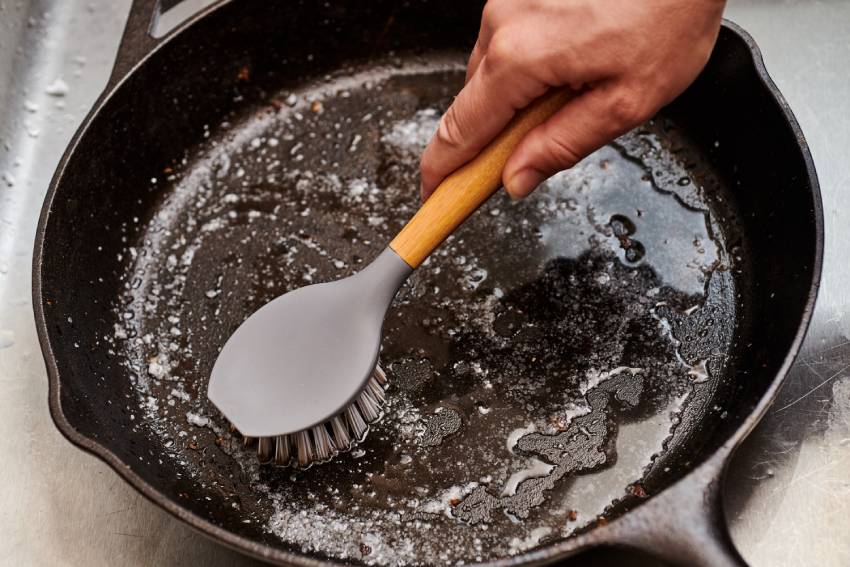
How to clean cast iron pans
Cast iron pans scare away a lot of home cooks because they think they’re difficult to clean. But with the right care, cast iron pans can last longer than almost any other cookware you might use. The most important thing to remember with cast iron is to avoid temperature shock. If the pan is hot, use hot water. And if it’s cold, use cold water!
You should always wash cast iron by hand. It won’t last long inside a dishwasher.
- Pour out an excess oil or grease
- Rinse your cast iron pan in hot water while it’s still warm
- Use a brush or pan scraper to remove any burned-on food
If your cast iron pan cooled and now won’t clean properly, you can remove stubborn marks by heating it again.
- Pour a little water into the pan to cover the base to about ½ inch deep
- Put the pan on the cooker and slowly bring the water to a boil
- Use a pan scraper or brush to work stubborn food free using the hot water
- Wash the pan as usual to thoroughly clean it
After each use, your cast iron pan should also be oiled. Dry the pan thoroughly using a microfiber cloth or paper towel. Then season the pan with a small amount of cooking oil. Use a paper towel to rub the surface and remove any oily residue.
Lodge cast iron pan manufacturers say it is okay to use a small amount of dish soap if necessary to clean cast iron pans. However, you should avoid doing this more than necessary. Dish soap can cut through the protective seasoning of the pan and cause it to rust.
Pro Tip: Dirty oven? Learn how to clean your oven like a Pro!
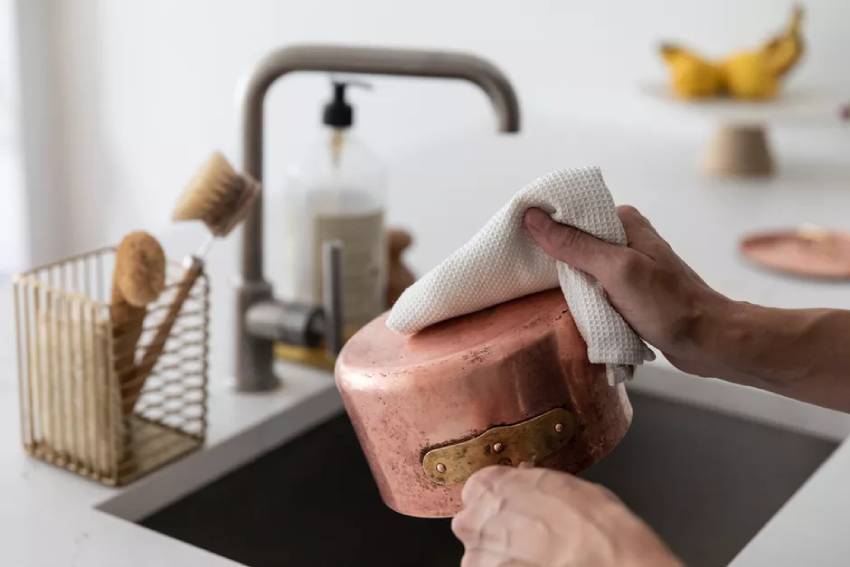
How to clean cast iron skillet rust
If your cast iron pan does rust, it isn’t the end of the world. You just have to remove the rust and re-season the pan.
Step 1: Scrub the pan with soapy water and steel wool to remove the rust
Step 2: Rinse the pan and dry thoroughly
Step 3: Apply a thin layer of cooking oil all over the pan
Step 4: Use a cloth or paper towel to remove excess oil
Step 5: Place the pan upside down on the top rack of the oven
Step 6: Bake at 450-500 degrees for 1 hour
Step 7: Allow the pan to cool completely
You may need to repeat steps 3-7 several times to build up the black patina that indicates a properly seasoned pan.
Pro Tip: Place a baking sheet on the bottom rack to catch any oil drips.
How to clean copper pans
Copper pans are also prized kitchen possessions. Copper is naturally antimicrobial, so it is one of the safest choices for food preparation. In addition, copper is a great thermal conductor, resists corrosion, and is very easy to clean. It’s no wonder copper pans have been prized by chefs for centuries!
When it comes to cleaning copper pans, you do need to take some extra precautions. Copper is a delicate metal, so abrasive cleaners like scourers can scratch the surface of your pans. Copper is also reactive and may discolor after contact with commercial pan cleaning solutions.
Most copper pans are lined with tin, which makes a great non-stick surface. You can clean the inside of your lined copper pans with a sponge, water, and a drop of dish soap. If you do get food stuck inside a copper pan, soak it in hot water for 15 minutes and then try again with the soap and sponge. Once the pan is clean, dry it thoroughly with a microfiber cloth to prevent the copper tarnishing.
How to clean nonstick pans
Nonstick pans are very convenient for cooking, but the nonstick coating can get damaged by abrasive cleaners. Nonstick coatings are also heat-sensitive, so follow these tips to get the most from your nonstick pans. You’ll most often find nonstick coatings on frying pans.
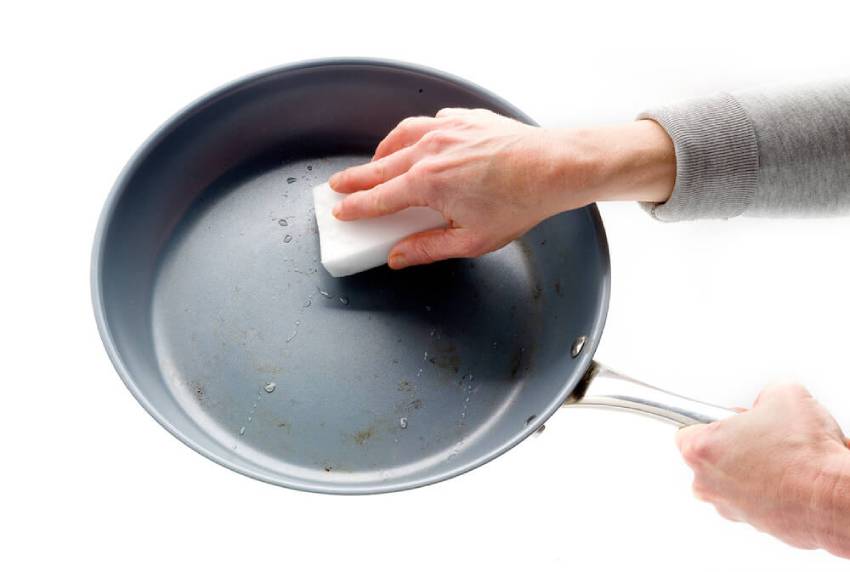
How to clean frying pans
- Let the pan cool completely before cleaning to prevent warping
- Use dish soap to remove grease residue after use, as this can damage the coating
- Avoid using steel wool or abrasive cleaners on nonstick pans
- Use a damp sponge and coarse salt to remove tough stains
- Dry the pan with a microfiber cloth after cleaning
If your nonstick coating starts to peel, it’s time to replace the pan. Most nonstick pans have a lifespan of about five years, which is shorter than other cookware.
PAN |
DISH SOAP |
BAKING SODA |
VINEGAR |
Aluminum |
✓ |
✓ |
✓ |
Cast iron |
Sparingly |
✓ |
X |
Copper |
✓ |
✓ |
✓ |
Nonstick |
✓ |
✓ |
✓ |
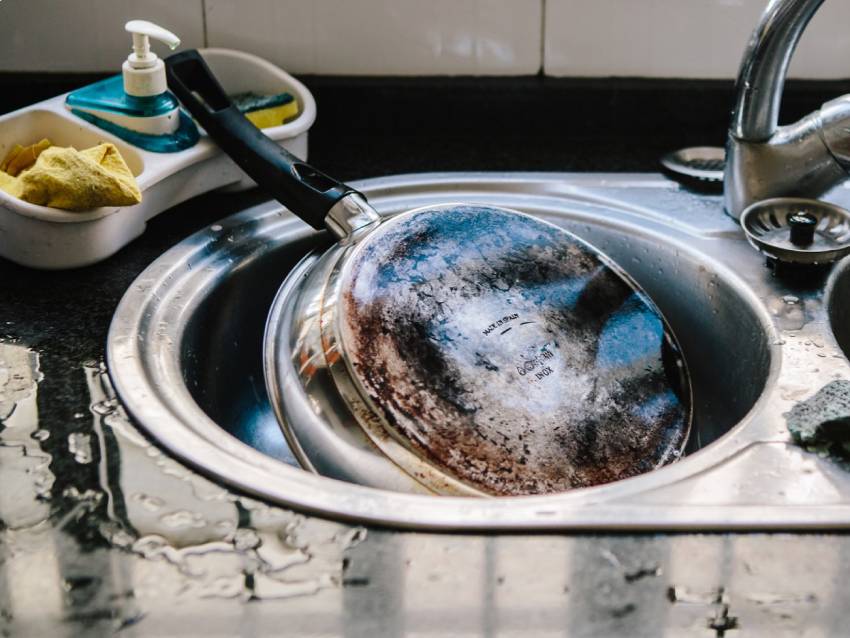
How to clean burnt pans
Sometimes accidents happen and pans end up very burned or discolored. Don’t worry, they can still be salvaged. Just try one of these methods.
Cleaning a burned pan with vinegar and baking soda
- Half-fill the pan with a 50/50 mixture of water and white vinegar
- Bring to the boil and add 2 tablespoons of baking soda
- Remove from the heat and let stand for 15 minutes
- Discard the water/vinegar mixture and scrub the pan with a brush
- Repeat as necessary
Cleaning a burned pan with baking soda
- Fill a large pot or pan with water and add ½ cup of baking soda
- Place the burned pan into the pot, fully submerged if possible
- Bring the water to the boil
- Boil for 15 minutes
- Remove the burned pan and scrub with a brush
Cleaning a burned pan with lemons
- Fill the pan with water
- Add 1-2 lemons, sliced
- Bring the water to a boil
- Remove the pan from heat after 5-10 minutes
- Discard the lemons and hot water
- Clean the pan with soapy water and a scrubbing brush